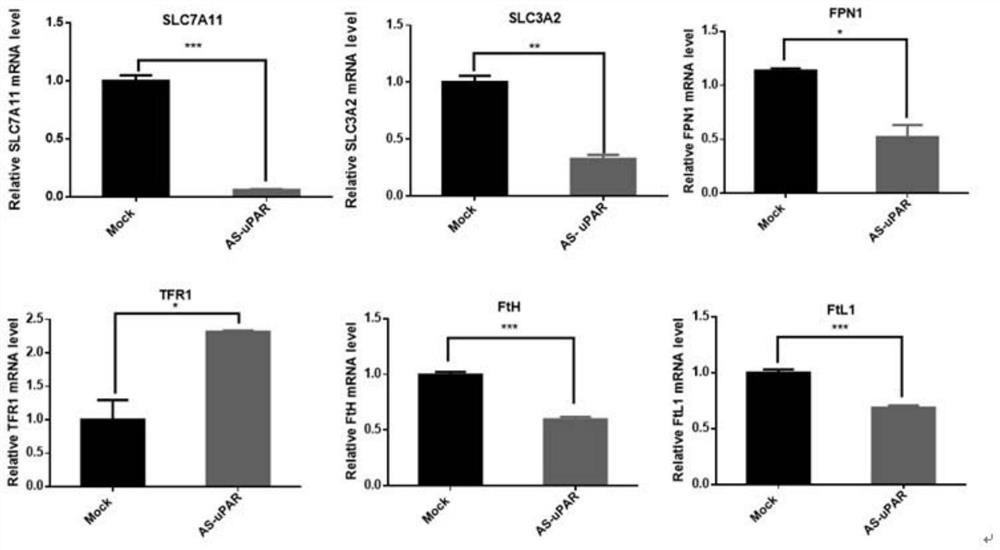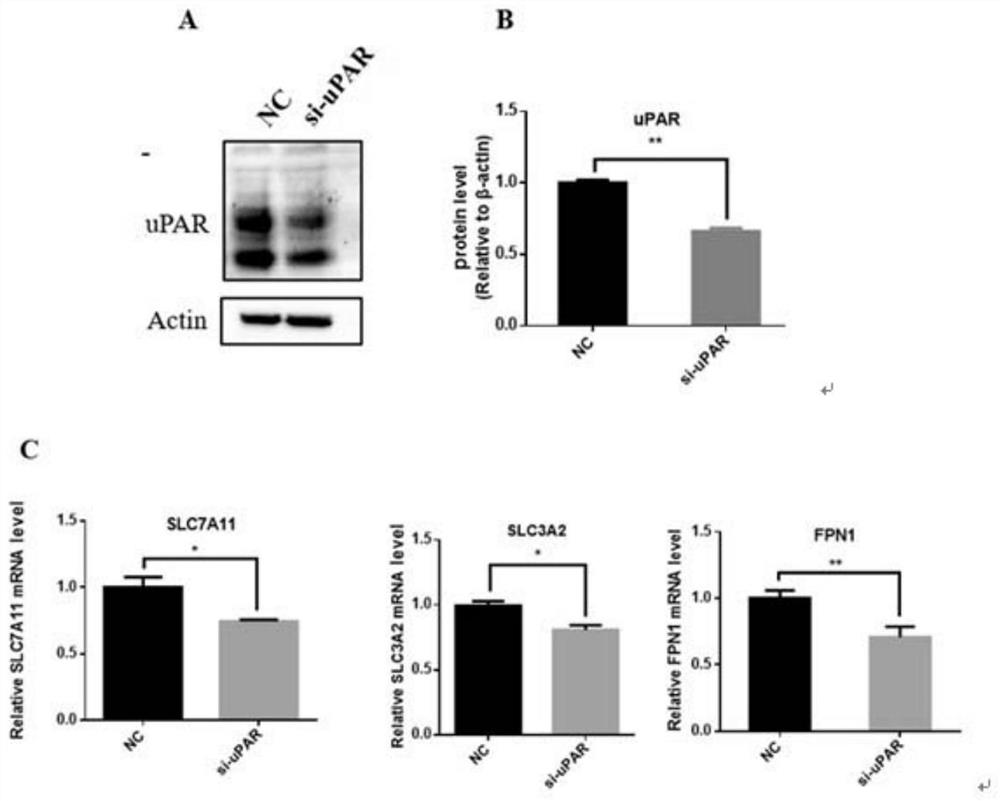Method for enhancing sensitivity of tumors to drug
A technology of drug sensitivity and sensitivity, applied in the field of biomedicine, can solve the problems of lack of methods to enhance the sensitivity of tumors to drugs, and achieve the effect of enhancing sensitivity
- Summary
- Abstract
- Description
- Claims
- Application Information
AI Technical Summary
Problems solved by technology
Method used
Image
Examples
Embodiment 1
[0029] Such as figure 1 As shown, a method for enhancing the sensitivity of tumors to drugs of the present invention comprises the following steps: enhancing the sensitivity of human tumor cells to drugs by down-regulating the expression of prourokinase receptor uPAR.
[0030] Inhibit the expression of prourokinase receptor uPAR through RNA interference and antisense nucleic acid to enhance the sensitivity of tumor cells to drugs.
[0031] It can significantly down-regulate the expression levels of ferroptosis-related genes uPAR, SLC7A11, SLC3A2, FPN1, TFR1, FtL1, FtH, and GAPDH at the same time, and enhance the sensitivity of tumor cells to drugs by regulating the ferroptosis signaling pathway.
[0032] Such as figure 2As shown, the nucleotide sequence of the upstream primer of the uPAR is shown in SEQ ID No.1, and the nucleotide sequence of the downstream primer of the uPAR is shown in SEQ ID No.2; the SLC7A11 The nucleotide sequence of the upstream primer is shown in SEQ...
Embodiment 2
[0036] HCT116 is a human colon cancer cell line, and the present invention uses this cell line as the main model for validation. The construction and verification of the antisense-uPAR stable cell line (AS-UPAR) of the cell line and its control cell line (Mock) and the design of siRNA were derived from previous work (Xiufeng Liu et al., Apoptosis, 2014, 19:1532–1544 )
[0037] CCK8 explores the effect of uPAR on ferroptosis
[0038] a) uPAR participates in the regulation of Erastin-mediated ferroptosis: HCT116 Mock and AS-uPAR cells were collected into EP tubes, counted with a cell counter, adjusted the cell concentration, mixed and added to a 96-well plate. Each well contains 10,000 cells in a volume of 200 μL. After all the wells were added, 100 μL of PBS was added to the surrounding wells of the 96-well plate to reduce the experimental error caused by medium volatilization; the cells were cultured overnight, and the drug (Erastin) was administered when the cell density gr...
Embodiment 3
[0041] Extraction of total RNA from HCT116 Mock and AS-uPAR cells
[0042] Take out the small culture flask full of HCT116 Mock and AS-uPAR cells from the cell culture incubator, carefully aspirate the medium, rinse with 2mL PBS for 3 times, and finally aspirate the PBS. Add 1mL Trizol reagent to lyse the cells for 5min. Take out the suspension containing the above cells, put it in a 1.5mL EP tube, add 200μL of chloroform, cover the tube cap, shake vigorously for 20s, and let it stand at room temperature for 3min. Centrifuge at 12,000 rpm for 10 min at 4°C, the mixture is divided into two layers, and the RNA is located in the supernatant of the upper layer. Subsequent operations require the use of nuclease-free pipette tips. Use a pipette to carefully draw 500 μL of supernatant, and transfer it to a nuclease-free EP tube, then add 500 μL of isopropanol, mix the liquid in the tube gently, let stand at room temperature for 10 minutes, and centrifuge at 12,000 rpm at 4°C After...
PUM
 Login to View More
Login to View More Abstract
Description
Claims
Application Information
 Login to View More
Login to View More - R&D
- Intellectual Property
- Life Sciences
- Materials
- Tech Scout
- Unparalleled Data Quality
- Higher Quality Content
- 60% Fewer Hallucinations
Browse by: Latest US Patents, China's latest patents, Technical Efficacy Thesaurus, Application Domain, Technology Topic, Popular Technical Reports.
© 2025 PatSnap. All rights reserved.Legal|Privacy policy|Modern Slavery Act Transparency Statement|Sitemap|About US| Contact US: help@patsnap.com



